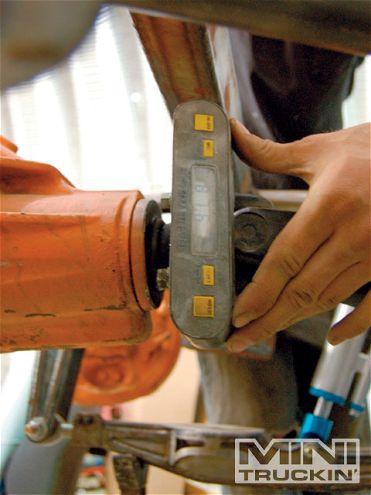Maximized - Eliminating Driveline Vibration - September 2009

| maximized Dear Mini Truckin September 2009 ujoint
Since Max is over there thinking he's all smart and things, how 'bout you have him tell me why my truck always vibrates so much when I'm out and about chasin' mud rats in the hills. I read sumthin' bout when the driveshaft angles are off and such that this might cause a little jitter here and there. And while he's at it, tell him that I want to know what is so dang important about the three-degrees pointing down at the rearend that I keep reading about. That part really makes no sense to me at all and really confuses the bejesus out of me!
Thanks for all your help and keep on makin' the best mag out there, I always make sure to pick it up every month at the local piggly wiggly.
Jasper Cogwillows
Gainesville, Missouri
Via horse and carriage
Hey Jasper,
Thanks for taking the time out of your busy mud rat chasin' schedule to write in, as this is actually a great question. My good friend and fellow shop owner, Eric Saliba from The Little Shop of Horrors, and I were talking about this very topic just this evening. It's a bit tough to explain exactly everything that is going on with a U-joint as it rotates while at an angle, but I'm going to do my best to clarify it without complicating things too much.
As a U-joint rotates through an entire 360-degree rotation, it goes through four complete different phases. Depending on the orientation of the joint itself, the joint will alternate pushing or pulling through every 90 degrees of rotation; the greater the angle of the joint, the greater the length of the oscillations and so the more potential for driveline vibrations will exist. Eliminating driveline vibration is as simple as canceling the oscillations of the front U-joint by creating equal but opposite oscillations in the rear U-joint. The orientation of the u-joints on almost any driveshaft is such that the only thing that we need to concern ourselves with is matching the angle of the U-joint on the rearend to the angle or combination of angles of the front U-joint(s). As simple as that might sound, it can get fairly confusing at times, especially when a carrier bearing is involved. As a side note, '60s Cadillacs and Lincolns had a special type of U-joint called a double-cardan joint. This type of joint had two u-joints in one that would cancel all oscillations within it. But enough about that old car stuff.
This brings us to your second question, why the three degrees pointing down. Well Jasper, the three degrees is just a little rule of thumb to help the general population in their search for a smooth riding 'bagged vehicle. In some instances you might run as much as six degrees or as little as one degree, it really just depends on the compliance of your rear suspension. You would almost always run the pinion angle pointing slightly down because it is the acceleration forces that you are trying to fight, as there are little to no driveline forces under braking so the angle is negligible. A stock leaf spring suspension will have a lot more bending and twisting than a four-link with Heim joints would have. So you would have more initial angle on a leaf spring car than a four-link car. Even if you had Heims on everything so that there was zero theoretical movement, there is still enough flex in the bars or chassis to concern yourself with at least a degree of initial angle to keep vibration at bay.
I hope this helps make your mud rat hunting more pleasurable...
Thanks,
Max Fish - The Mad Scientist of Suspension
To submit a question, email: mini.truckin@sorc.com
 | maximized Dear Mini Truckin September 2009 ujoint
Since Max is over there thinking he's all smart and things, how 'bout you have him tell me why my truck always vibrates so much when I'm out and about chasin' mud rats in the hills. I read sumthin' bout when the driveshaft angles are off and such that this might cause a little jitter here and there. And while he's at it, tell him that I want to know what is so dang important about the three-degrees pointing down at the rearend that I keep reading about. That part really makes no sense to me at all and really confuses the bejesus out of me!
Thanks for all your help and keep on makin' the best mag out there, I always make sure to pick it up every month at the local piggly wiggly.
| maximized Dear Mini Truckin September 2009 ujoint
Since Max is over there thinking he's all smart and things, how 'bout you have him tell me why my truck always vibrates so much when I'm out and about chasin' mud rats in the hills. I read sumthin' bout when the driveshaft angles are off and such that this might cause a little jitter here and there. And while he's at it, tell him that I want to know what is so dang important about the three-degrees pointing down at the rearend that I keep reading about. That part really makes no sense to me at all and really confuses the bejesus out of me!
Thanks for all your help and keep on makin' the best mag out there, I always make sure to pick it up every month at the local piggly wiggly.